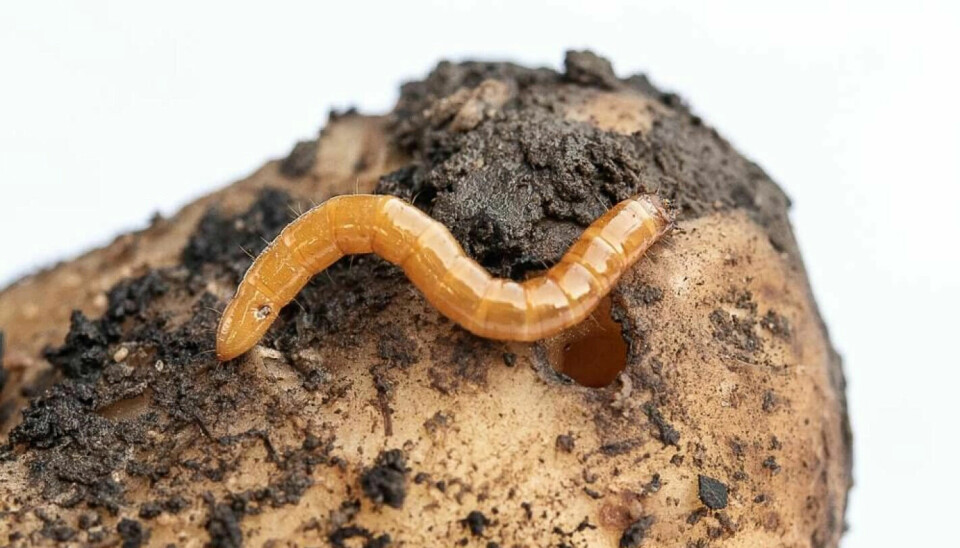
How to avoid larvae in potatoes you grow yourself
If you want to grow potatoes in your own kitchen garden on a part of your lawn, you are almost guaranteed to be attacked by wireworms. The potatoes will be riddled with larvae. However, with a few simple steps, you can avoid them.
Lately, more and more people have started growing vegetables in their own gardens.
Many may think they can just harrow a corner of the lawn to plant potatoes.
“But that’s a huge mistake,” Annette Folkedal Schjøll tells sciencenorway.no.
She is a researcher at the Norwegian Institute of Bioeconomy Research (NIBIO).
Because you’re almost guaranteed to be attacked by wireworms.
Wireworms are not worms, as the name suggests. They are beetle larvae, specifically the larvae of a group of beetles called click beetles.
Jump into the air with a click
The beetles themselves are fascinating, according to the researcher.
“If you place an adult click beetle on its back, it will jump into the air with a little click after a short while – and hopefully land on its feet,” she says.
But the beetles lay eggs in the lawn in the spring, and the larvae live underground for several years, feeding on grass roots. Although the eggs are laid in the grass, the larvae will eat almost any kind of roots.
If potato sprouts and new potatoes suddenly appear in the soil, it will become a feast of a lifetime for them.

Moves vertically in the soil layers
The larvae move up and down in the soil beneath the lawn. During winter and early spring, they are usually deep in the ground. So, if you dig up the top layer of grass on the lawn, you may not see them.
“The larvae overwinter deep in the soil, and they may not have emerged yet when you plant the potatoes. When the soil warms up in spring, the larvae come up to feed on roots after a long winter hibernation,” Folkedal Schjøll explains.
In the middle of summer, when it's too hot and dry, the larvae crawl downward in the soil to avoid drought. In late summer and autumn, they come back up and continue to feed.
If you harvest the potatoes early, you may be lucky. But most people who plant potatoes in their lawn will experience their harvest being riddled with wireworms.
How to avoid wireworms
There are some measures you can take to avoid them.
“To reduce the number of wireworms in the soil, you can plow the lawn area and grow other crops there for three to four years,” Folkedal Schjøll says.
This is the time it takes for the larvae to become adult beetles that no longer harm the plants.
Plowing also brings the larvae to the surface, where they are exposed to being eaten by other insects and birds.
“Many birds love wireworms,” she says.

Choose only above-ground crops
If you want to grow something useful, it's important to choose vegetables that grow above ground, the researcher emphasises.
Avoid root vegetables like carrots, swedes, and other vegetables where the edible part grows underground.
Both buckwheat and mustard greens are poor host plants and can reduce the number of wireworms in the soil.
“Onions can work as well, but we have seen cases where onions are also attacked. It’s best to plant seedlings that are growing well and can tolerate some root damage without dying,” the researcher says.
Lettuce or cabbage crops may work fine, even though wireworms can also attack them.
Raised beds
After three to four years, wireworms will be gone from that area.
As long as there is no grass growing in the cultivation area, there will be no new egg-laying, and the wireworm problems will cease.
“If they come back, it’s important to rotate the crops and grow something else there,” Folkedal Schjøll says.
Another way to grow potatoes without getting wireworm attacks is by using raised beds with a fiber cloth or other material that protects against the soil.
However, in this case, you should buy soil. If you use soil from your lawn, there is a high risk of it containing wireworms.
Fungus is a natural enemy
Another solution is a fungus that attacks wireworms and other insects. It naturally occurs in many gardens and is called Metarhizium brunneum.
It is an insect pathogen, meaning it attacks and kills the insect, but it is not harmful to humans.
“The wireworms are lured into a death trap where the fungus kills them,” the researcher says.
In Germany, a product using this fungus to combat wireworms has been developed. The product takes advantage of the wireworm’s attraction to CO2 emitted by roots.
Granules are spread in the soil when planting potatoes. These granules release CO2, which attracts the wireworms, making them think there are plenty of delicious roots to eat. However, the granules also contain fungal spores.
“These fungal spores attach to the wireworms, germinate, and grow inside the insect, eventually causing its death,” she says.
Professional growers in Germany use this method to combat wireworms. The product is not yet available in Norway. However, the method has been tested in a Norwegian research project.
“Additionally, a Norwegian variant has been tested, which is better adapted to the slightly cooler Norwegian climate,” Folkedal Schjøll says.
Buy certified seed potatoes
When it comes to growing potatoes, it is crucial that you do not use potatoes purchased from the store for consumption. They can spread diseases.
Only use certified seed potatoes for cultivation.
“This is because certification provides assurance that the seed potatoes are free from dangerous pests. The content of commonly occurring diseases (viruses, bacteria, and fungi) should also be as low as possible,” Anette Sundbye says.
She is a researcher at the Norwegian Institute of Bioeconomy Research (NIBIO).
Certified seed potatoes are publicly controlled, and you can buy them at garden centres.
Check the Plant Protection Encyclopedia
Another typical potato pest is late blight, which is a fungal disease.
You can read about this and other diseases in the Plant Protection Encyclopedia (link in Norwegian).
This online encyclopedia is created by NIBIO.
Based on the pictures and descriptions, you can identify which disease your plants probably have.
Here, you can also learn more about pests like wireworms (click beetles), garden bugs, and the dreaded Colorado potato beetle.

———
Translated by Alette Bjordal Gjellesvik.
Read the Norwegian version of this article on forskning.no
































